Wine Lister’s COO, Chloe Ashton shares her thoughts on this year’s en primeur campaign so far.
The latest Bordeaux en primeur campaign is already underway, with Batailley 2021 opening the stage at the beginning of last week, and Domaines Baron de Rothschild’s Carruades and Duhart-Milon following suit. Cantemerle’s release on Friday 13th rounded out the week, and thus far starting prices have been a relatively pleasant surprise.
What does the trade expect from this year’s campaign?
In Part I of Wine Lister’s annual Bordeaux study, we asked key members of the global fine wine trade about their expectations ahead of the 2021 campaign. Of 47 respondents, half expected prices to be somewhat more expensive, or significantly more expensive than 2020 vintage releases, after rumblings on La Place of strong trading over the past few months.
 Bordeaux study (p.10): Founding members survey – 2021 release price expectations
Bordeaux study (p.10): Founding members survey – 2021 release price expectations
After the first physical en primeur week in Bordeaux since the 2018 vintage (our view of the vintage can be found here), the trade will at least have had the chance to work their way through a vintage so complex that tasting was surely a necessity. With such a heterogenous vintage, pricing strategies should logically also be extremely varied, making the potential successes of 2021 sales difficult to predict. Nonetheless, here’s what we know:
- Wine Lister’s annual Bordeaux study reveals that confidence in Bordeaux us up. Respondents increased ratings on last year for three quarters of the wines included in our study – after so many trade members have been reminded of the joys of tasting in situ, both these elements could contribute to campaign positivity and momentum, with merchants backing those properties they historically believe in, and/or were indeed impressed by during en primeur tastings
- 2021 appears to be a vintage that speaks from the soil, so imparting knowledge of the best terroirs to customers should help to create demand for the best-performing wines in general
- Outside of focusing only on the very best, 2021 may be a vintage for pleasant surprises – the fresher, lower-alcohol, and more classical style of wines certainly garner appeal from traditional palates, so any merchant or collector seeking this style of drinking experience in the near to mid future could do well in seeking out some of the better-value wines hailing from this complicated campaign
Wine Lister’s wine-by-wine analysis of this year’s campaign is available in email newsletter form through a Pro+ subscription. For more information on this, please contact us.
Wine Lister’s Founder and CEO, Ella Lister shares her thoughts on Bordeaux’s 2021 vintage.
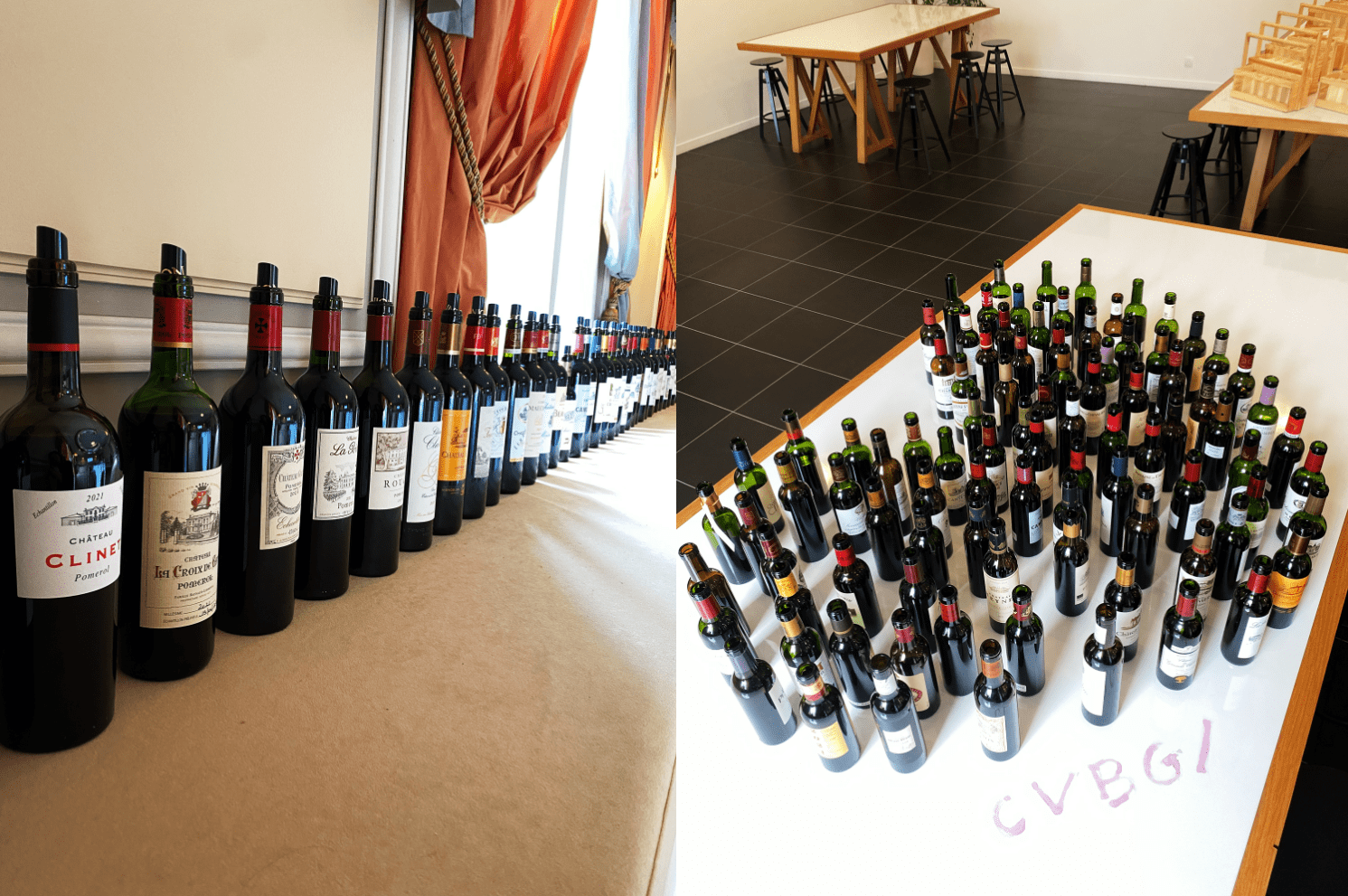 Bordeaux en primeur tastings: UGCB (left) and CVBG (right)
Bordeaux en primeur tastings: UGCB (left) and CVBG (right)
What can we expect from Bordeaux 2021?
The most complicated vintage since 2013, Bordeaux 2021 had everything thrown at it. The vines suffered a barrage of challenges during the growing season, from frost, then mildew, to a lack of the all-important hydric stress during a cool, cloudy summer. “It was a tiring vintage for us, and psychologically difficult” recalls Juliette Couderc, the new technical director at Château L’Evangile.
Bordeaux had been lucky with six relatively clement vintages in row, and en primeur tasters had been spoiled – especially with the trio of 2018, 2019, and 2020. Tasting more than 350 wines from the 2021 vintage in late April, we were reminded of en primeur tastings of old – the art of seeing through the wood, the hard tannins, the searing acidity, and attempting to form an idea of the wine’s future potential. And potential there is, if much less widespread than in the last three years. Buying decisions will need to be made carefully, and the critics’ views will be more important than in recent vintages blessed with high quality across the board.
Vinegrowing and winemaking have come on even in nine years, with know-how and tools at the disposal of producers that they didn’t necessarily have in 2013. Furthermore, 2021 had a saving grace – an unusually long growing season, beginning with early bud break, around the beginning of April, and ending with harvest dates running well into October, thanks to an Indian summer that finally provided some much-needed sunshine, with the sunniest October since 1991. Pierre-Olivier Clouet, technical director of Château Cheval Blanc, referred to a vintage “slow-cooked at a low temperature” following six years of cooking “on a high heat”.
The vintage was more challenging for merlot than for cabernet (franc or sauvignon), as the grape variety is more susceptible to mildew. Being an early ripener, merlot also missed out on the best of the Indian summer, whereas much cabernet benefitted from a warm and sunny early October, where vignerons dared to ignore the pessimistic weather forecasts for the weekend of 3rd and 4th October and hadn’t already rushed to pick before the non-existent rain. “The weather forecast was predicting an apocalypse,” recalls Vincent Millet, managing director of Château Calon-Ségur in Saint-Estèphe, but the cabernet grapes weren’t ready, so he waited, “and in the end there was no rain at all, and then a good stint of sunshine”. Further south in Margaux, Alexis Leven-Mentzelopoulos, co-owner of Château Margaux, echoes, “It was out of the question to pick unripe grapes ”.
At Château Ducru-Beaucaillou in Saint-Julien, owner Bruno Borie says the 2021 vintage is an “ode to cabernet sauvignon, which was much more resistant than merlot at every step.” However, cabernet’s upper hand in 2021 does not neatly translate into a left-bank vintage as might be expected. The right bank has its fair share of hits, and, bizarrely, fewer misses.
The watchword in 2021 is heterogeneous, and quality is undoubtedly very patchy in 2021, ranging from the seriously disappointing to the truly exceptional (though we are not in 100-point territory in this vintage). This makes it a hugely interesting en primeur campaign to taste, to sell, and to buy. It is a year where châteaux had a real opportunity to stand out from the pack, usually thanks to outstanding terroir and the application of significant resources – both financial and human. “It was viticulture seven days a week,” explains Jean-Emmanuel Danjoy, estates manager of the Château Mouton-Rothschild stable, who, like many others, underlined the vital importance of the team’s unstinting dedication. It was necessary to adapt tirelessly in the vineyard and in the winery; to accept that the fruit coming in at the end of the season wasn’t that of the three previous vintages, and be willing to throw out tried and tested recipes to make a different kind of wine, suited to the vintage. “We didn’t go looking for density that simply wasn’t there”, underlines Vincent Decup, technical director at Château Montrose in Saint-Estèphe. Down the road at Cos d’Estournel, Dominique Arangoïts points out “it’s an opportunity for wine lovers to really uncover the terroir, because the wines are stripped right back.”
The biggest challenges were to achieve a full enough body and to avoid vegetal (pyrazine) notes, without over-extracting hard, green tannins or being over-reliant on new wood, which the more delicate fruit couldn’t absorb. Many of the more successful properties used gentler extraction techniques than ever, and added a significant proportion of press wine to fill out the mid-palate. Chaptalisation was widely resorted to for the first time since 2013. The 2021 vintage nonetheless offers refreshingly modest alcohol levels – around 13% rather than the 15% or 15.5% which had become ubiquitous in recent years – potentially a key selling point with consumers.
Generalisations are not easy (or wise) in a vintage of such disparity of quality and style, but with few exceptions, the red wines tend to come in a lighter, fresher vein, recalling the classical clarets of the 1980s and 1990s. “It’s a wine style from the 80s, but with ripe grapes,” muses Aymeric de Gironde, president of Château Troplong-Mondot. The fruit is more red than black, with lots of raspberry and even some rhubarb. The vintage is less opulently floral than the last three, and floral notes are more often on a slightly more vegetal spectrum – iris, violet and lily. The worst wines have hollow mid-palates and searing acidity, and often an overdose of oak. The very best are so pure and soothing that you would never imagine the sweat and tears that went into making them. For Olivier Gautrat, maître de chai at Château L’Eglise Clinet, it was “a difficult and exhausting vintage. We’ve been out of the habit of less explosive flavour in the grapes, so we were really scared, but the more we taste, the more we find real charm in the 2021s. ”
The dry whites are pure and fresh, and the best have a sumptuous complexity. The sweet whites are remarkable, but produced in tiny quantities, if at all. For this reason Christian Seely describes Château Suduiraut 2021 as “tragically beautiful”, with yields of less than 1 hl/ha. What the reds, whites, and sweet wines all share is high acidity, which will likely result in long ageing capacity. We look forward to tasting the wines again in bottle in a couple of years to confirm that!
350+ tasting notes will be published (in French) at Le Figaro Vin next week. In the meantime, watch this space for part II of this blog series, with a focus on the Bordeaux market, to be published next week. To track the impending Bordeaux en primeur releases, click here to discover our en primeur page.
In anticipation of this year’s en primeur releases, Wine Lister has published Part 1 of its annual in-depth Bordeaux Study. In collaboration with the world’s most visited wine website, Wine-Searcher, our market overview examines the region’s price performance and comparative popularity progression. Drawing upon valuable insight from 47 leading trade survey respondents, the study also identifies which properties have benefited from a rise in trade confidence over the past year, and explores recommendations for châteaux and merchants to see a successful 2021 en primeur campaign.
Please see our key findings below:
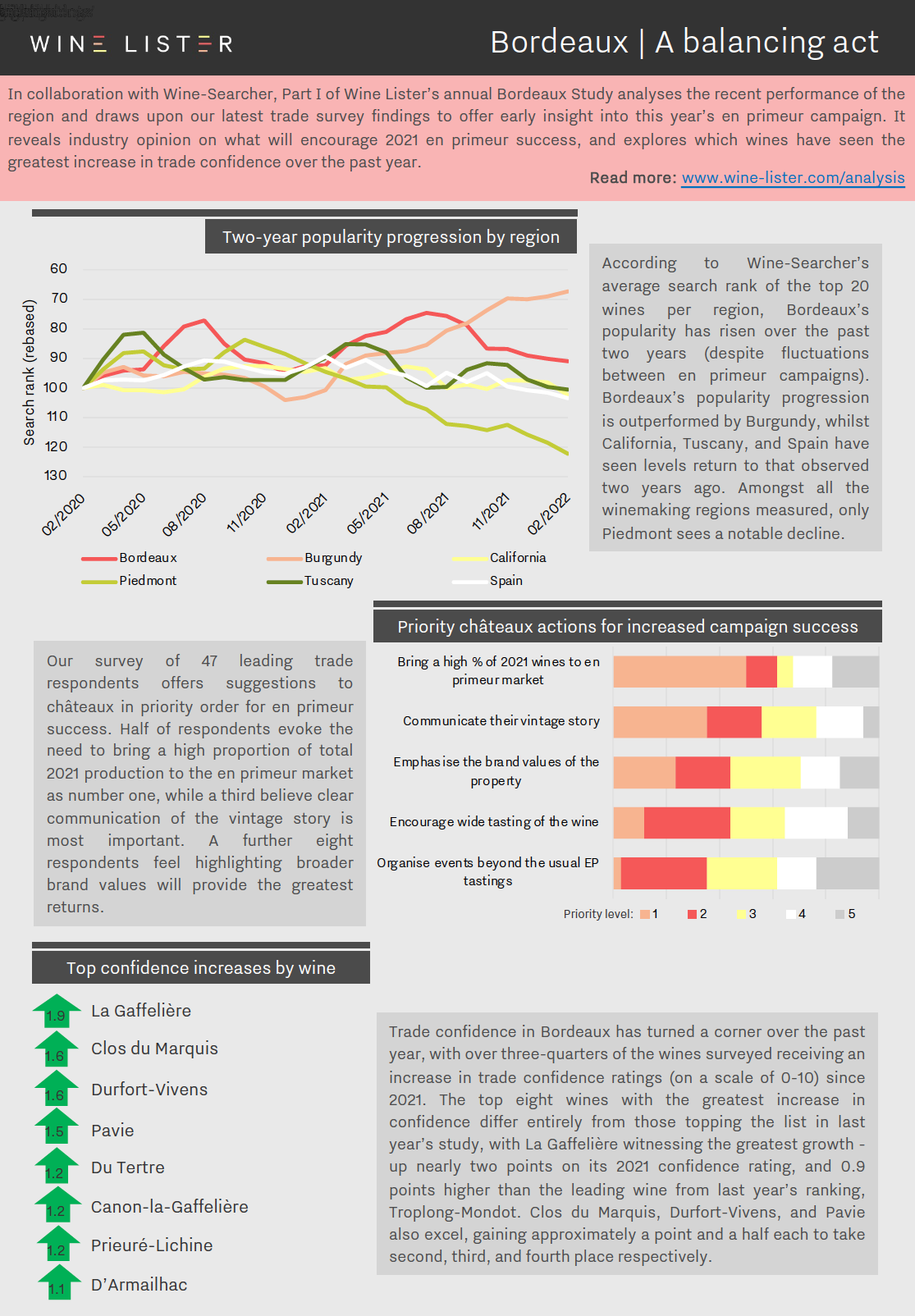
You can download the study digest here: Wine Lister 2022 Bordeaux Study – Digest. The full report can be purchased on our Analysis page, while Pro subscribers can access their free copy here. For further information on the data source, please see the Wine-Searcher website here.
A tour of the town with our Pessac-Léognan friends
The Larrivet Haut-Brion team joined Wine Lister to catch up with industry friends and meet some new faces in London’s fine wine scene after two years of restricted travel. Alongside a wine and cheese consumer tasting and a trade lunch, a series of individual merchant meetings provided the chance for the team to reunite with a market close to their hearts.
 Larrivet Haut-Brion in London: (from left) Brand Ambassador Clara Bouineau, Technical Director François Godichon, Managing Director Bruno Lemoine
Larrivet Haut-Brion in London: (from left) Brand Ambassador Clara Bouineau, Technical Director François Godichon, Managing Director Bruno Lemoine
What are the latest developments at Larrivet Haut-Brion?
The viticultural evolution at Larrivet Haut-Brion kick-started with the arrival of their Managing Director, Bruno Lemoine in 2007. Fascinated by the mosaic soil structure unique to the property (with top-soils composed in patterns of graves, colluviums, or sand and clay-limestone), Bruno conducted extensive terroir analysis which informed a detailed replanting programme, allowing the team to better match grape varieties to soil types for optimum quality. Among other changes, this led to an increased proportion of Cabernet Sauvignon and Cabernet Franc vines planted across the vineyard sites.
Further changes were implemented in 2015 with the arrival of Technical Director, François Godichon, who integrated several new production methods informed by his Burgundian roots. His parcel-led approach was reinforced in 2018 with the construction of a new cellar with space and facilities for a more precise vinification of individual micro-plots.
The final piece in Larrivet Haut-Brion’s winemaking puzzle, Cellar Master, Charlotte Mignon joined the team in 2020 and drives continuous experimentations with different ageing vessels, including combinations of concrete eggs, terracotta amphorae, and both new and old oak barrels. With Charlotte unavailable to join the visit (having just welcomed her second child), the London trio was completed by the property’s Brand Ambassador, Clara Bouineau, who joined the team in January 2022.
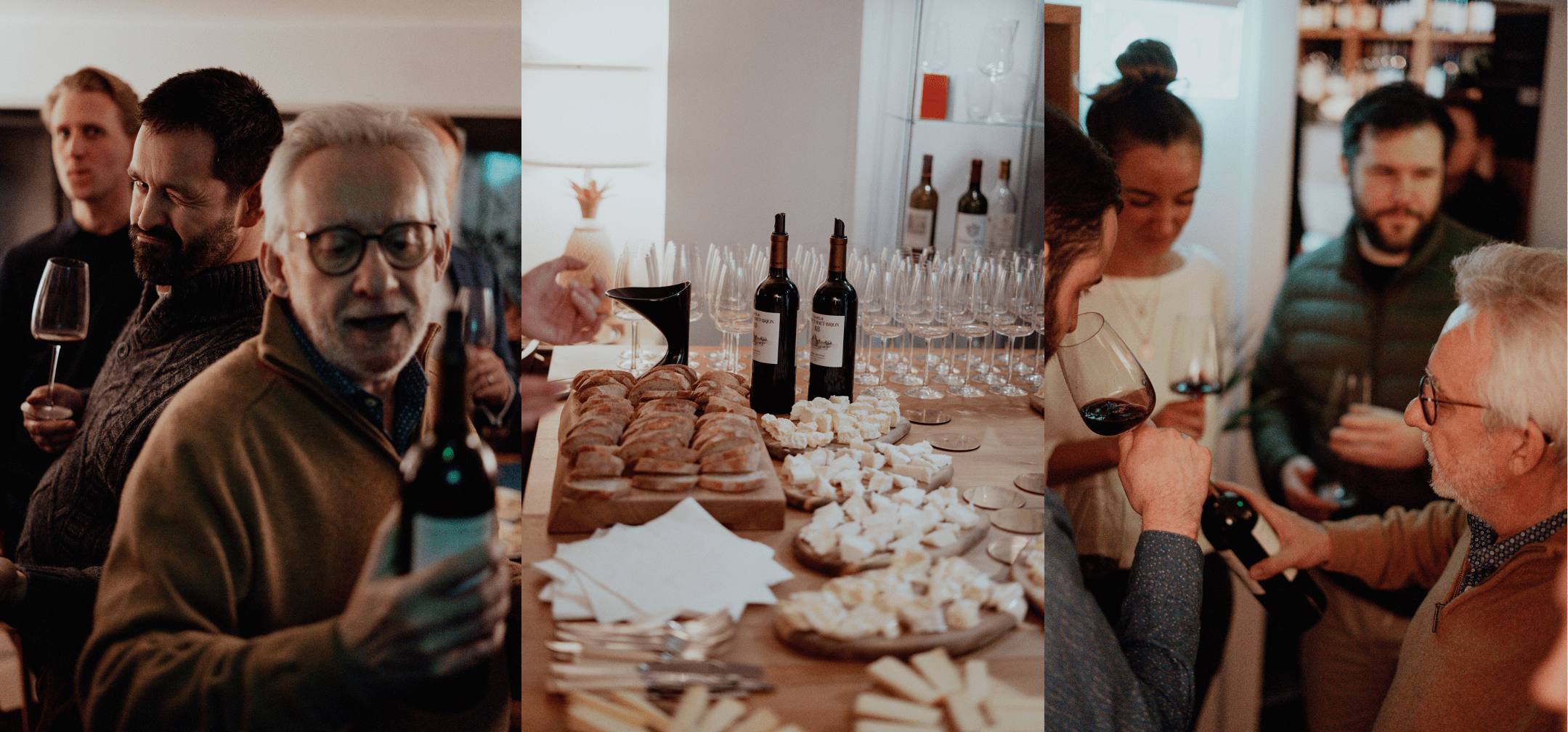 Wine and cheese tasting: Bruno and François tell guests about their wine (left), wine and cheese at Must & Lees (middle), Bruno pouring wine for guests (right)
Wine and cheese tasting: Bruno and François tell guests about their wine (left), wine and cheese at Must & Lees (middle), Bruno pouring wine for guests (right)
A marriage of Bordeaux wine with British cheese
The first stop on Larrivet Haut-Brion’s London tour was specialist wine shop Must & Lees, where the team was joined by some of North London’s Bordeaux enthusiasts for a wine and cheese evening on Wednesday 23rd February. Celebrating the estate’s commitment to the UK market, Wine Lister and Larrivet Haut-Brion devised a tasting format that showcased their red and white wines alongside a selection of 100% British cheeses from Neal’s Yard Dairy. While providing the opportunity for the team to build relationships with its consumers, the evening showcased the suitability of Larrivet Haut-Brion wines with some of the UK’s favourite fromages, including the likes of St Jude and Colston Bassett Stilton.
Wine and cheese pairing: Larrivet Haut-Brion Blanc 2017 with Sinodun Hill, Les Demoiselles Blanc 2019 with St Jude, Larrivet Haut-Brion Blanc 2014 with Baron Bigod, Larrivet Haut-Brion Blanc 2007 with Durrus, Les Demoiselles Rouge 2019 with Ogleshield, Larrivet Haut-Brion Rouge 2017 with Colston Bassett Stilton
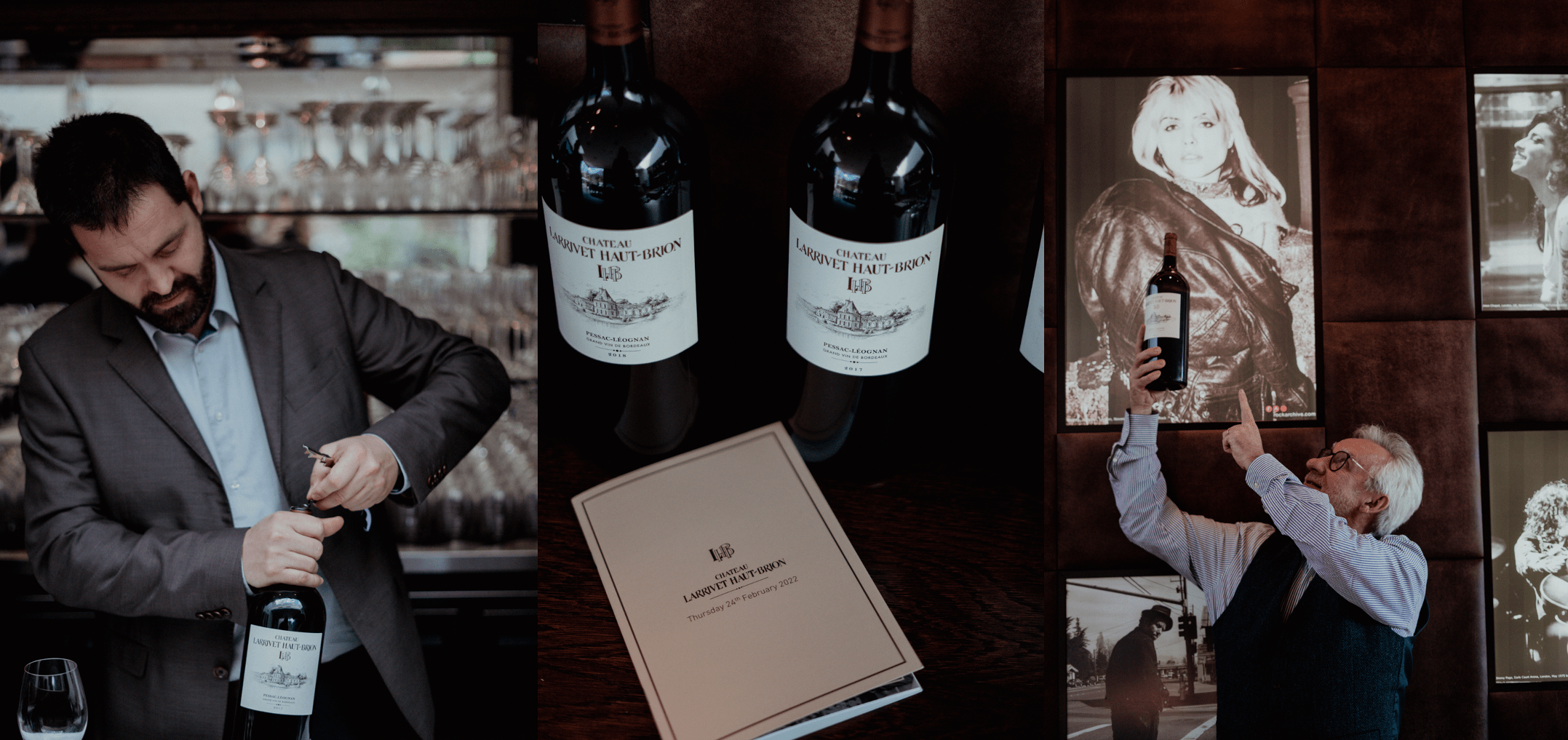 Frederick’s trade lunch: François opening a 2015 magnum (left), magnums on display with bespoke booklet (middle), Bruno presenting a magnum (right)
Frederick’s trade lunch: François opening a 2015 magnum (left), magnums on display with bespoke booklet (middle), Bruno presenting a magnum (right)
A taste for technical developments
Having already met with some of London’s key fine wine merchants, on Thursday 24th February, Wine Lister invited a handful of its fine wine trade and press friends for lunch at Frederick’s to discover some of Larrivet Haut-Brion’s best recent vintages in magnum.
With positive feedback across the board, Larrivet Haut-Brion’s whites showed freshness and complexity, thanks to the blending of Sauvignon Blanc with Sémillon from old vines grown on limestone soils. Alongside an impressive showing of some iconic recent vintages of reds (including 2005, 2010, 2015), the 2017 Rouge provided a promising picture of the future of Larrivet Haut-Brion 2021, with a low proportion of Merlot offset by a higher percentage of Cabernet Franc mirroring the projected blend of this year’s release – which may contain no Merlot at all.
To round off the lunch, the Larrivet Haut-Brion team poured some of their favourite wines from outside the property – an exercise that they believe is crucial to learn and gain inspiration from others. Amongst their “beyond Bordeaux” selection were Pierre Gerbais’ Prestige Extra Brut, Mas Jullien 2018, and Domaine Moingeon Saint-Aubin 1er Cru Sur Gamay 2018 – each giving guests a glimpse into the team’s personal preferences.
Wines tasted: Les Demoiselles Rouge 2019, Larrivet Haut-Brion Rouge 2019, Larrivet Haut-Brion Rouge 2018, Larrivet Haut-Brion Rouge 2017, Larrivet Haut-Brion Rouge 2016, Larrivet Haut-Brion Rouge 2015, Larrivet Haut-Brion Rouge 2010, Larrivet Haut-Brion Rouge 2005, Les Demoiselles Blanc 2020, Larrivet Haut-Brion Blanc 2020, Larrivet Haut-Brion Blanc 2019, Larrivet Haut-Brion Blanc 2018, Larrivet Haut-Brion Blanc 2011
For further information on WLPR’s tastings and events, please contact the team here.
Rounding off this year’s en primeur campaign, Wine Lister’s partner critic platform, JancisRobinson.com has now published its top Burgundy 2020 scores, with further insight into the latest vintage from Jancis Robinson, alongside Matthew Hayes, and fellow Masters of Wine, Andy Howard and Julia Harding.
Explore all Burgundy 2020 scores here, or read more below.
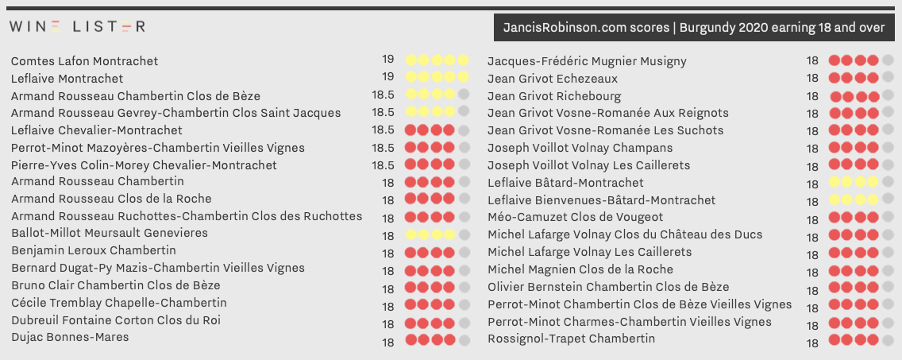
Amongst the 36 Burgundy 2020s that earn 18 and over, five wines receive 18.5 points and two receive a score of 19 – a slight reduction from the number of top scorers in last year’s campaign, with Jancis awarding 18.5 points to 18 Burgundy 2019s and a score of 19 to four wines.
Whites continue to steal the show across this year’s releases, with four receiving a score of 18.5 and above – compared to just one featured within the same parameters last year. Sharing a near-perfect score of 19 are Montrachets from Comtes Lafon and Leflaive – Matthew Haynes describes the former as “honed, dense, and focused”, and the latter as having a “beautiful balance and drive.”
Two producers dominate JancisRobinson.com’s top Côte de Nuits red scores; Armand Rousseau is featured five times in the list, for its Chambertin Clos de Bèze, Gevrey-Chambertin Clos Saint Jacques, Chambertin, Clos de la Roche, and Ruchottes-Chambertin Clos des Ruchottes, and Jean Grivot earns four places, with Richebourg, Echezeaux, Vosne-Romanée Les Suchots, and Vosne-Romanée Aux Reginots all achieving 18 points.
Despite the hot and dry summer causing difficulty to some of the Côte de Beaune reds, four wines from Volnay shine through; Michel Lafarge’s Volnay Les Caillerets and Clos du Château des Ducs, and Joseph Voillot’s Volnay Champans and Les Caillerets.
Discover more Burgundy 2020 scores from Wine Lister’s partner critic, Neal Martin here, an regional specialist, Jasper Morris here.
Insight from Burgundy’s regional specialist
Wine Lister’s partner critic and leading Burgundy expert, Jasper Morris MW completed the release of his Burgundy 2020 scores last week. Below we take a closer look at his top ratings per appellation subset.
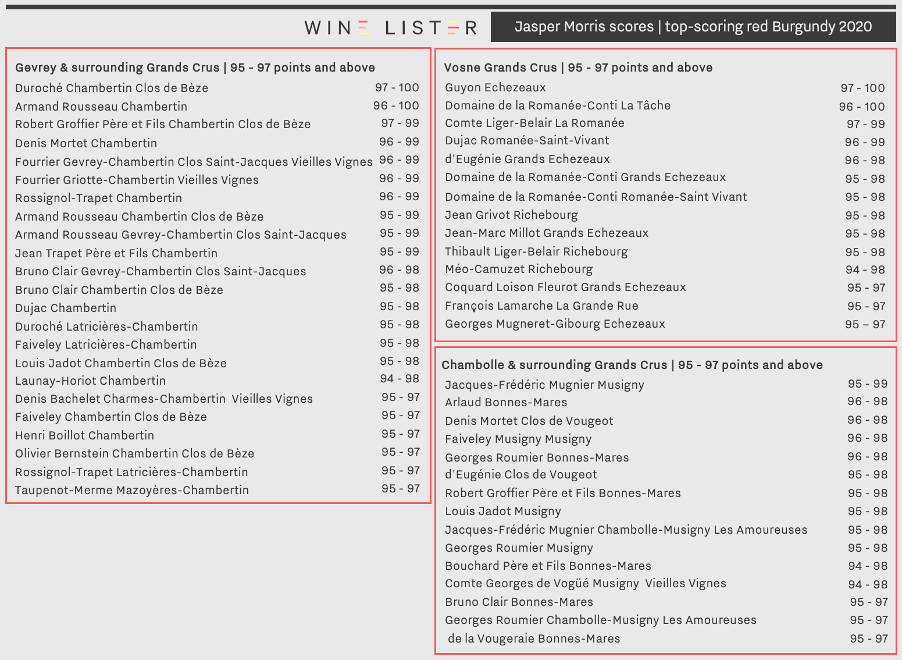
How did Burgundy’s appellations perform in 2020?
Jasper Morris’ Burgundy 2020 report outlines the challenges brought about by such a hot and dry summer, with soaring temperatures throughout August leading to a deficit of juice, particularly in Pinot Noir. The inability of certain rootstock to deal with the hot dry conditions led to the threat of dieback disease (a fungal disease that attacks the trunk, appearing more frequently in stressed vines), with Jasper noting he has “never seen as many vines being ripped out as [he] did in autumn 2020”. Indeed, both factors resulted in relatively low yields for reds, with a number of producers in the Côte de Nuits having “made more wine in the frost-damaged 2021 vintage than they did in 2020.”
Nonetheless, Jasper reported that the hydric stress “concentrated everything, including acidity”, identifying wines with “profound intensity beyond anything [he] saw in 2018 and 2019.” He describes a “universally successful vintage for the white wines”, and a “wider range of styles and successes in the reds”.
Côte de Nuits
With almost all of his top scores given as ranges, much of Jasper’s tasting this year took place whilst wines were still in barrel, as many producers were “tempted to increase the length of élevage for their wines, especially the reds, given the exceptional concentration of the fruit”. This contrasts with the majority of singular scores awarded to the in-bottle samples he rated at the same time last year, and while 2019 did not see any potential 100-point wines, the Côte de Nuits 2020s have five.
The selection includes Duroché’s Chambertin Clos de Bèze and Armand Rousseau’s Chambertin, with the former released as a limited edition cuvée to mark 100 years since the Duroché family planted vines on the site. Also potentially perfect are Guyon’s Echezeaux and Domaine de la Romanée-Conti’s La Tâche, with Jasper suggesting the former “could be THE wine of the vintage.” Completing the line-up is Perrot-Minot’s Richemone Vieilles Vignes, a Premier Cru with a vibrancy that Jasper considers “almost unsurpassed anywhere in the Côte”.
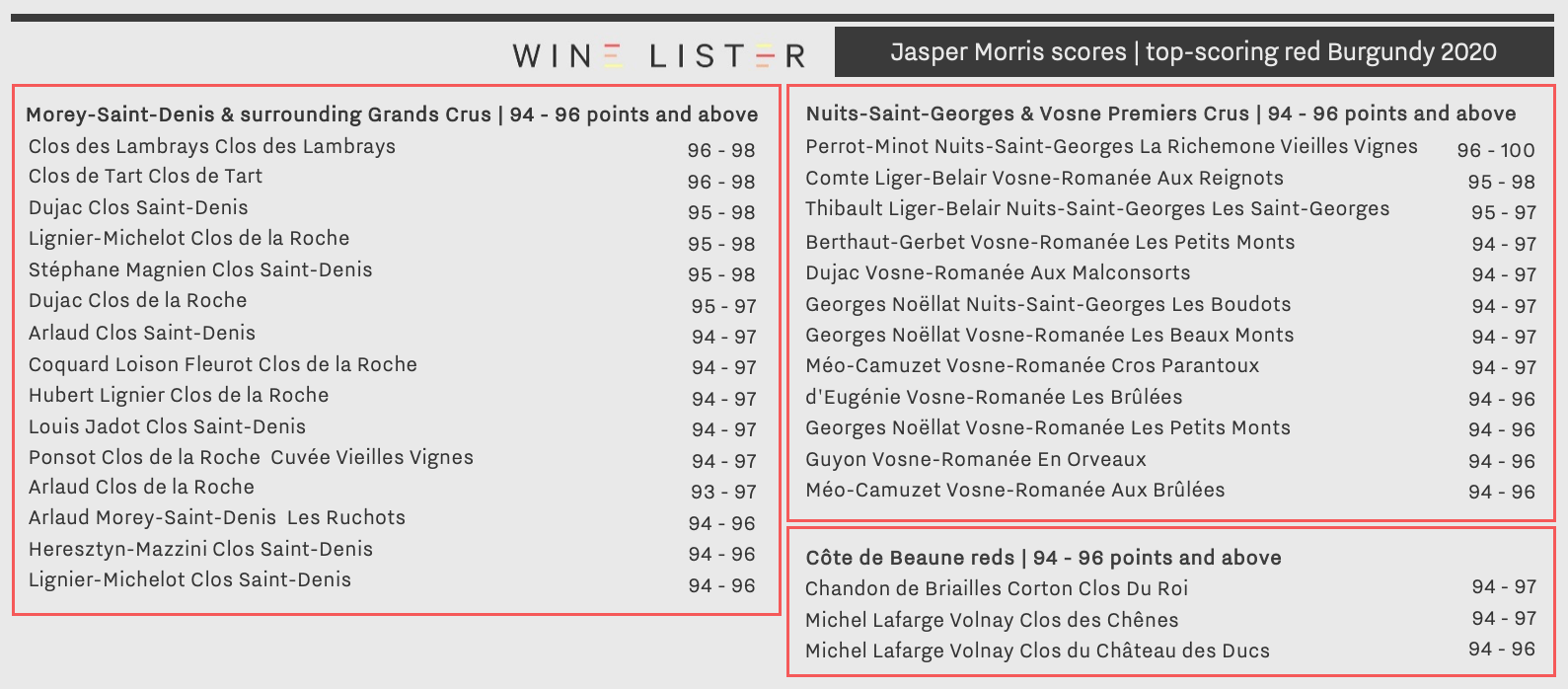
Within Morey-Saint-Denis and its surrounding Grands Crus, Clos de Tart’s namesake cuvée shares the top score for a second year in a row, earning 96 – 98 points, having been complimented for its “spectacular depth”. Clos de Lambrays – nurtured by Clos de Tart’s previous winemaker, Jacques Devauges, since 2019 – matches the rating.
Côte de Beaune – reds
Jasper reports that the most challenging conditions were felt where grapes typically ripen first, including the southern villages of Volnay and Corton. Despite this, several reds including Michel Lafarge’s Volnays Clos des Chênes and Clos du Château des Ducs, and Chandon de Briailles’ Corton Clos du Roi fare well, the latter described as having the “most sensual nose of all”, with notes of “alpine raspberries”.
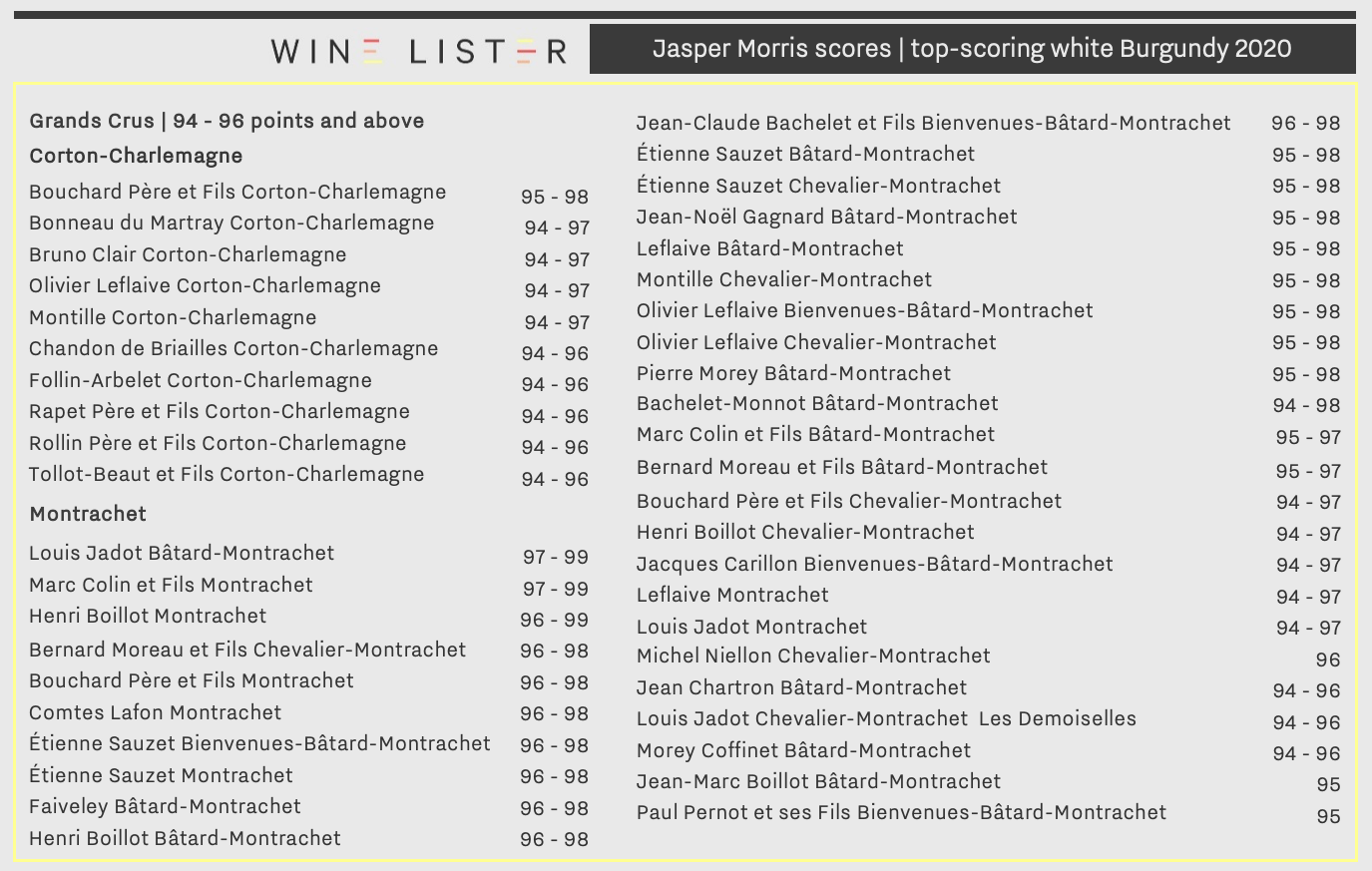
Côte de Beaune – whites
Jasper awards 71 white Burgundy 2020s a score of 94 – 96 and above, compared with last year’s 29 wines scoring 95 and above. He stresses the success of the 2020 vintage across the whites, with Chardonnay grapes retaining more juice than Pinot Noir, and benefitting from a longer ripening time. Montrachet and associated white Grands Crus saw two wines with a potential 99 points – Marc Colin’s Montrachet and Louis Jadot’s Bâtard-Montrachet.
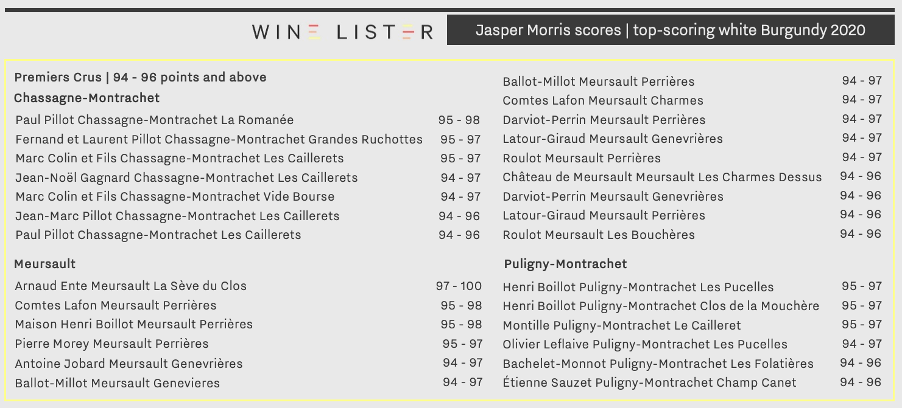
Bouchard Père et Fils’ Corton-Charlemagne achieves a score of 95 – 98, and is praised for expressing “a really impressive wealth of fruit”. Earning the only potential 100-point score for whites in 2020, Arnaud Ente’s Meursault La Sève du Clos was particularly memorable, with Jasper affirming that he has “never seen this consistently great wine as expressive before”.
Explore Jasper Morris’ full Burgundy 2020 report here. For more Burgundy 2020 commentary from our partner critics, recap Neal Martin’s ratings here, and stay tuned for the last lot of scores from Jancis Robinson.com.
The first of Wine Lister’s partner critics to release scores for the latest Burgundy vintage, Neal Martin’s assessment (for Vinous) provides initial insight into some of the top en primeur picks in 2020.
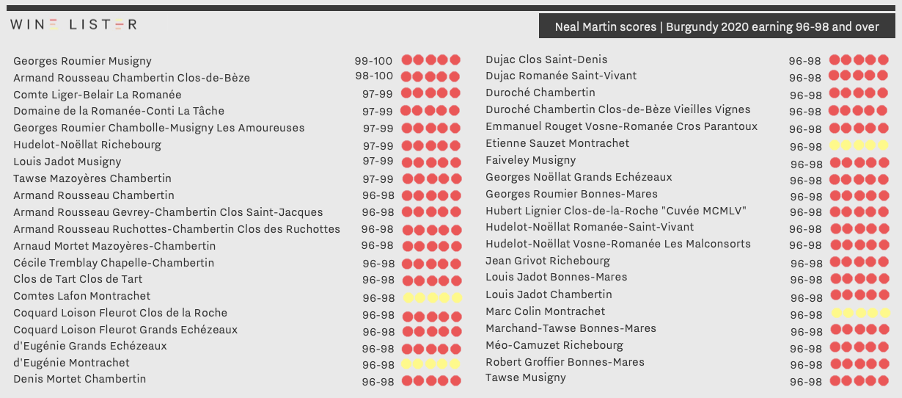
What do we know about Burgundy’s 2020 vintage so far?
2020 will be remembered as a year that saw some of the earliest harvest dates ever recorded in Burgundy, with several of the region’s producers picking as early as 12th August. Though following the pattern of recent vintages marked by warm and dry growing seasons, the threat of drought was partly alleviated by significant rainfall during the winter months through to spring, which ensured water reserves were replenished ahead of the heat. Some Pinot Noir producers nonetheless saw a drop in yields, particularly on sites with poorer soils, and thus restricted water retention ability.
Dry conditions during ripening minimised the threat of disease and mildew, which was valuable for the healthy growth of red and white grapes. Despite the earlier harvest, the grapes saw excellent ripening and phenolic development, while high levels of evaporation concentrated sugars, flavours, and acidity.
The top-scorers
Compared to the 19 wines that Neal Martin awarded 96-98 and above last year, there are an impressive 40 wines within the same parameter for the 2020 vintage. While there were no wines that earned a potential perfect score in 2019, Georges Roumier’s Musigny and Armand Rousseau’s Chambertin Clos-de-Bèze receive 99-100 and 98-100 points respectively in 2020. Neal Martin notes that the top-scoring reds of the vintage all share an excellent acidity, which “lends the 2020s a sense of brightness”.
Also faring notably well, Comte Liger-Belair’s La Romanée, Domaine de la Romanée-Conti’s La Tâche, Georges Roumier’s Chambolle-Musigny Les Amoureuses, Hudelot-Noëllat’s Richebourg, Louis Jadot’s Musigny, and Tawse’s Mazoyères Chambertin earn scores of 97-99.
Whites worth trying
Four whites hailing from Montrachet appear on the list, with offerings from Comtes Lafon, Domaine d’Eugénie, Etienne Sauzet, and Marc Colin each earning a score of 96-98. Neal Martin describes mineral notes across each, having written that this was one of the great attributes of the top whites in the vintage – especially across those grown on more “calcareous soils” akin to that which Montrachet boasts. Following the trend of white burgundy producers using less new oak, Marc Colin uses only old oak barrels for the first time in this vintage, while Comtes Lafon matured Montrachet in one-third new oak instead of 100%.
Discover Neal Martin’s full list of Burgundy 2020 scores here. Watch this space for further Burgundy 2020 score updates from Wine Lister’s partner critics, JancisRobinson.com, and specialist Burgundy critic, Jasper Morris MW.
22 Champagnes for 2022
Considering the latest industry insights shared in our annual end of year study, Wine Lister explores an eclectic range of Champagne MUST BUYs worth celebrating. With an initial selection made by our proprietary recommendation algorithm, based on quality and value within the category, we have singled out some top picks to pop open as we ring in 2022.
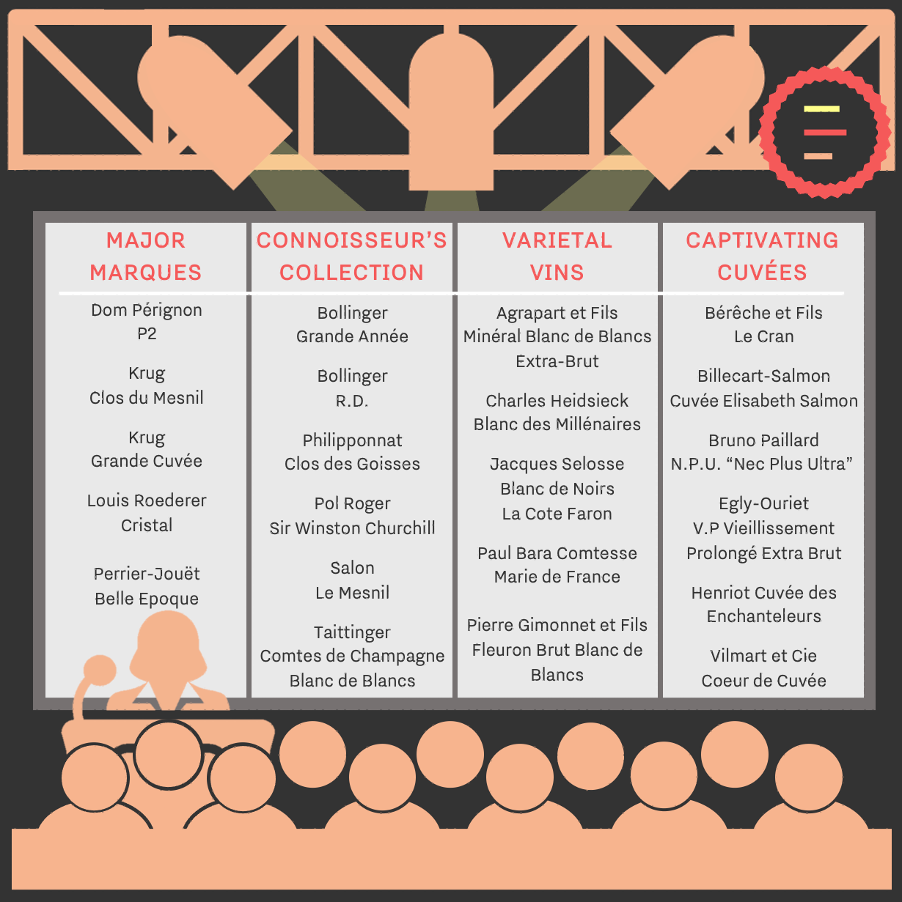 Wine Lister Leagues 2021: New Year’s Eve Champagne MUST BUYs (p. 17)
Wine Lister Leagues 2021: New Year’s Eve Champagne MUST BUYs (p. 17)
With demand for Champagne reaching record heights this year, Wine Lister’s latest Leagues explore a selection of top bottles to take you into 2022, featuring a variety of styles and price points across four categories: Major Marques, Connoisseur’s Collection, Varietal Vins, and Captivating Cuvées.
What Champagne should I buy?
Major Marques
A selection of Champagne’s strongest brands, the list of Major Marques features Krug’s Grande Cuvée and Clos de Mesnil alongside Louis Roederer’s Cristal, Perrier-Jouët’s Belle Epoque, and Dom Pérignon’s P2. The latter is considered a top Investment Staple, receiving recognition from the global fine wine market as a relatively stable and liquid option (discover our list of 2021 Investment Staples on p. 16).
Connoisseur’s Collection
Favourites among the trade and fine wine lovers alike, these insider icons include Philipponnat’s Clos des Goisses, Pol Roger’s Sir Winston Churchill, Salon Le Mesnil, and Taittinger’s Comtes de Champagne. Bollinger is featured twice in the line-up with its Grande Année and R.D. cuvées; with a distinguished history dating back to 1829, the estate has the only two vineyards in Champagne to remain phylloxera-free throughout the late 19th-century epidemic.
Varietal Vins
Our selection of Blanc de Blancs worth seeking out include Agrapart et Fils Minéral Extra-Brut, Pierre Gimonnet et Fils Fleuron Brut, and Charles Heidsick’s Blanc des Millénaires. Produced only in exceptional years, there have been four vintages of Blanc des Millénaires released since its inaugural 1983 vintage, with the cuvée spending a minimum of fifteen years maturing in the heart of Charles Heidsieck’s 2000-year-old underground chalk cellars (a UNESCO world heritage site) before release.
Made exclusively from Pinot Noir, Jacques Selosse’s La Cote Faro and Paul Bara’s Comtesse Marie de France also feature in the MUST BUY selection. A seventh-generation family business, Champagne Paul Bara is one of the few grower producers in Bouzy – a village widely regarded as amongst Champagne’s top sites for the production of Pinot Noir.
Captivating Cuvées
Sure to impress during the festive season, our list of Captivating Cuvées includes key grower producers Bruno Paillard, Bérêche et Fils, Vilmart et Cie, and Egly-Ouriet, whose featured wines each offer relative value within the selection of Champagne MUST BUYs. Henriot’s Cuvée des Enchanteleurs and Billecart-Salmon’s Cuvée Elisabeth Salmon complete the list – the latter being the only rosé Champagne featured, comprising a blend of around 50% Chardonnay and 50% Pinot Noir, of which 10% is vinified as red wine and incorporated into the final blend.
For further analysis on quality consistency, increased popularity, and a list of 2021s most compelling wines, download the Winer Lister Leagues 2021 here.
Increased interest online across both banks
Wine Lister’s annual in-depth study shines a spotlight on the pattern of increased interest in some Bordeaux wines over the past two years, with key properties across appellations seeing elevated popularity during the pandemic.
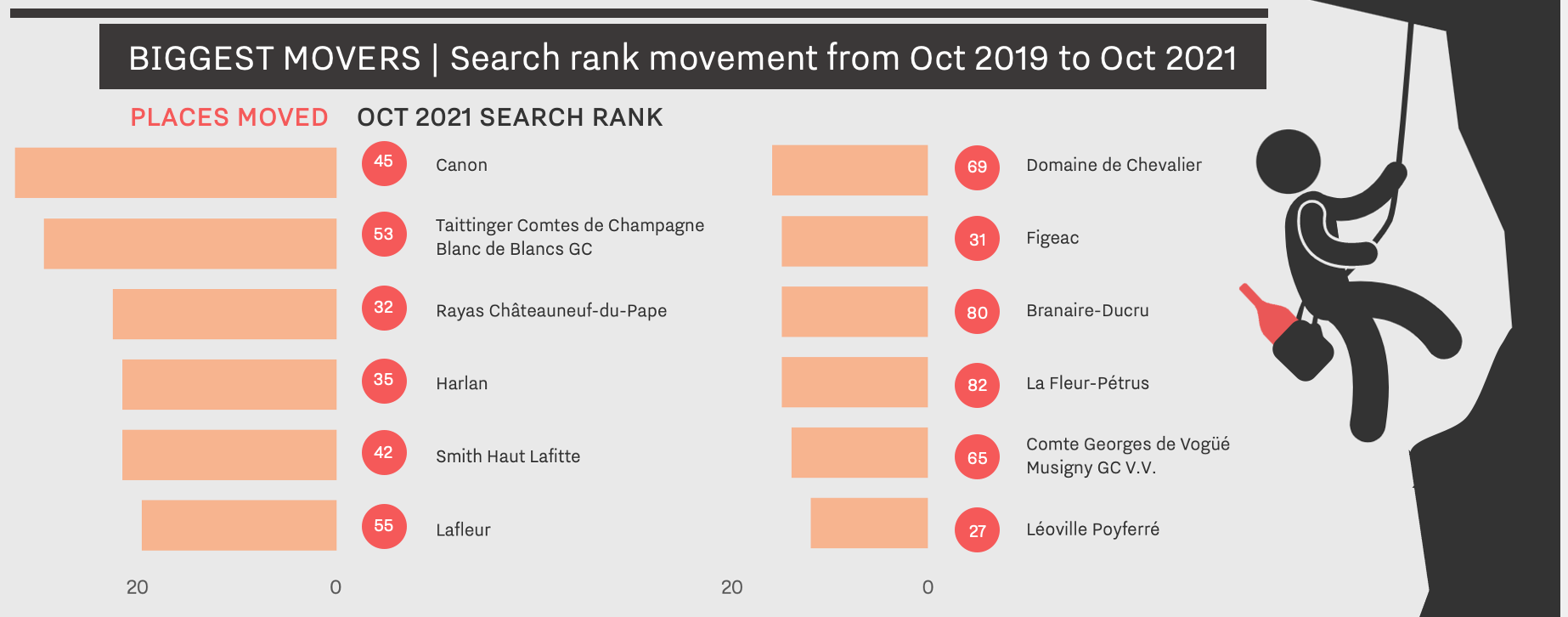 Wine Lister Leagues 2021: the Biggest Movers in search rank – Wine Lister’s measure of popularity (p.6)
Wine Lister Leagues 2021: the Biggest Movers in search rank – Wine Lister’s measure of popularity (p.6)
Using monthly search data from the most-visited wine website in the world, Wine-Searcher, Wine Lister’s Biggest Movers highlight wines whose online search rank has improved the most between October 2019 and October 2021 (within the top 100 most popular wines).
Which wines have seen the greatest increase in online popularity over the last two years?
The list of top 12 popularity movers comprises a range of price points, reflecting the broad spectrum of online fine wine enthusiasts, from cult classics to up-and-coming wines to watch. The findings indicate that appetite for Bordeaux has not waned, with increasing searches for Bordeaux bottles correlating to the success of the last two en primeur campaigns, within the context of a global pandemic.
Right Bank recognition
Rising 30 places, Canon was the biggest popularity mover, and takes first place in the League. Indeed, in February 2021, Wine Lister’s annual Founding Members Bordeaux survey revealed the trade’s opinion of Canon as having the most potential to see the greatest increase in demand in the near-to mid-term; naming Figeac a close second, which secures eighth position in this year’s Biggest Movers League.
Pomerol continues to prove popular – alongside Figeac, Lafleur has moved up 20 places, to sixth position in the League, while Jean-Pierre Moueix’s La Fleur-Pétrus is also featured, in 10th place.
Left Bank elevation
Two Pessac-Léognan properties appear in the top 12 Biggest Movers, with Smith Haut Lafitte and Domaine de Chevalier landing in fifth and seventh place respectively. Smith Haut Lafitte red 2020 received its highest score from Wine Lister partner critic, Antonio Galloni (for Vinous) of 95-97 points since the celebrated 2016 vintage – on release en primeur in June this year, it was announced that the bottles will sport special edition labels, marking owners’ Florence and Daniel Cathiard’s 30th harvest, and 655 years of the property.
Representing Saint-Julien, Léoville Poyferré and Branaire-Ducru have seen upward quality and popularity trajectories in recent years. With the latter boasting another 17-point score from Jancisrobinson.com for the 2020 vintage, the property continues to offer notable value for its quality.
Popular picks beyond Bordeaux
Harlan is the only non-French Biggest Mover this year, not least thanks to Will Harlan and his team’s conscientious efforts to maintain strong connections with the European fine wine trade. The only champagne to be featured in the League – Taittinger Comtes de Champagne Blanc de Blanc – has a strong reputation within the industry as one of the most tradeable Grandes Marques, with investment appeal encouraging its search rank to increase by 30 places in the past two years. The wine has gained further attention from the collector market following the postponed release of the landmark 2008 vintage, in October 2020.
A popular choice amongst the trade, Rayas’ Châteauneuf-du-Pape is cited in both Wine Lister’s articles on Drinking with experts: your favourite sommeliers’ favourite wines and Drinking with experts: your favourite winemakers’ favourite wines, and jumps an impressive 23 places in search rank, while collector’s favourite, Comte Georges de Vogüé Musigny climbs 14 places, to 11th in the League.
For the full analysis, download your free copy of Wine Lister’s 2021 Leagues here.
The insider’s guide to fine wine trends, and the most compelling wines to watch
Wine Lister has released its second annual Wine Leagues, celebrating some of the top-performing wines and producers in today’s new and much-diversified fine wine era. Informed by an in-depth trade survey with leading industry figures, the report provides a 360° view of those regions, producers, and wines that have seen strides in quality, popularity, economic promise, and more in 2021.
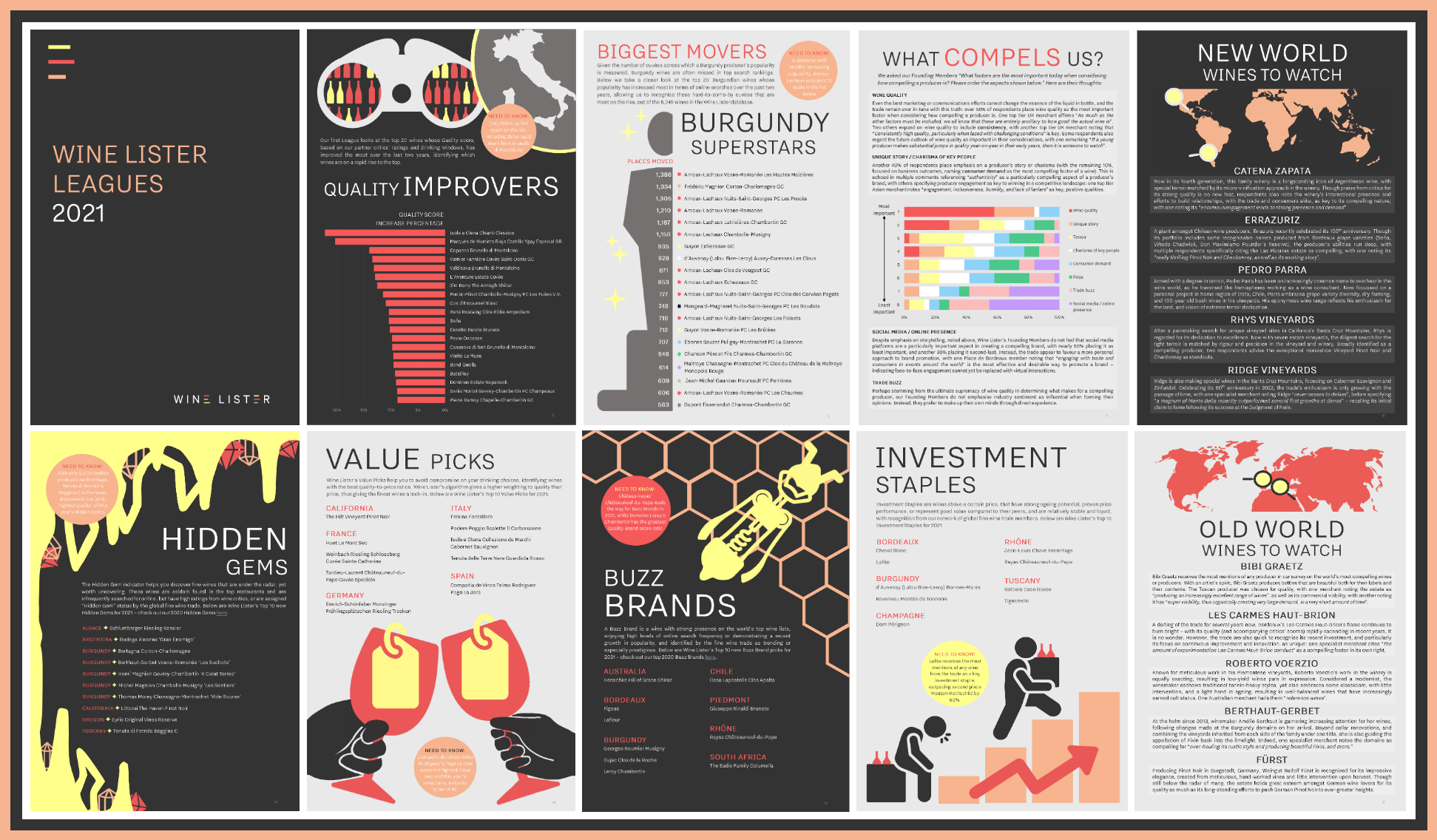
Wine Lister’s annual in-depth survey sees our expert panel of 47 CEOs, MDs, and wine department heads share their insight on some of the fine wines to have on your radar, as we ask them:
“What are the most compelling wines and producers in the market today?”
Respondents singled out 188 wines and producers collectively, that span no less than 20 major regions. Within the list, our team identifies Bibi Graetz, Les Carmes Haut-Brion, Roberto Voerzio, Berthaut-Gerbet, and Fürst as wines to watch in the Old World, whilst calling out the New World wonders of Catena Zapata, Errazuriz, Pedro Parra, Rhys Vineyards, and Ridge Vineyards.
The report also includes rankings across:
- Biggest quality improvers, which show impressive movement from Italy (occupying five places in the list of the top 20 by Quality score progression), with Isole e Olena Chianti Classico leading the pack
- Best search rank movers, wherein Bordeaux represents eight of the top 20 wines whose popularity has increased most in terms of online searches (including Smith Haut Lafitte, Domaine de Chevalier, Figeac, and Léoville Poyferré)
- Burgundy superstars, focusing on popularity movements from the trade’s darling region – Arnoux-Lachaux features 10 times in the list of top 20 Burgundian wines whose online searches have increased the most over the last two years
- Wine Lister’s top-10 recommendations per Wine Lister Indicator; Hidden Gems, Value Picks, Buzz Brands, and Investment Staples in 2021
For the full analysis, download your free copy of Wine Lister’s 2021 Leagues here.
 Bordeaux study (p.10): Founding members survey – 2021 release price expectations
Bordeaux study (p.10): Founding members survey – 2021 release price expectations











 Wine Lister Leagues 2021: the Biggest Movers in search rank – Wine Lister’s measure of popularity (
Wine Lister Leagues 2021: the Biggest Movers in search rank – Wine Lister’s measure of popularity (